5虚词的翻译
高考18个文言文虚词用法及例句翻译
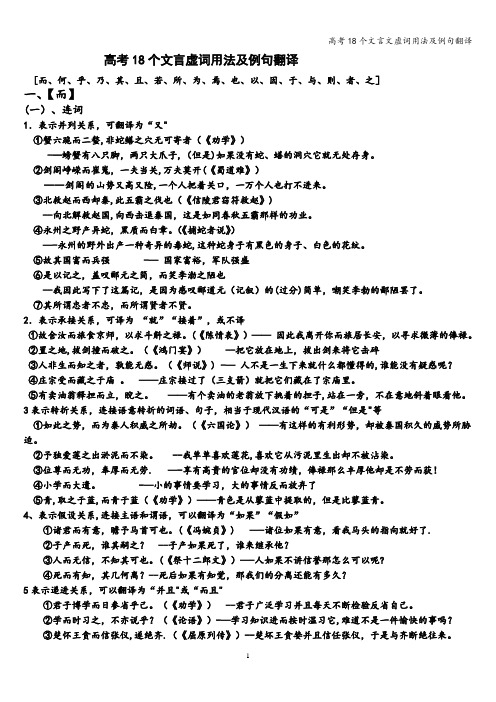
高考18个文言虚词用法及例句翻译[而、何、乎、乃、其、且、若、所、为、焉、也、以、因、于、与、则、者、之]一、【而】(一)、连词1.表示并列关系,可翻译为“又"①蟹六跪而二螯,非蛇鳝之穴无可寄者(《劝学》)-—螃蟹有八只脚,两只大爪子,(但是)如果没有蛇、蟮的洞穴它就无处存身。
②剑阁峥嵘而崔嵬,一夫当关,万夫莫开(《蜀道难》)——剑阁的山势又高又险,一个人把着关口,一万个人也打不进来。
③北救赵而西却秦,此五霸之伐也(《信陵君窃符救赵》)--向北解救赵国,向西击退秦国,这是如同春秋五霸那样的功业。
④永州之野产异蛇,黑质而白章。
(《捕蛇者说》)—-永州的野外出产一种奇异的毒蛇,这种蛇身子有黑色的身子、白色的花纹。
⑤故其国富而兵强 -—国家富裕,军队强盛⑥是以记之,盖叹郦元之简,而笑李渤之陋也--我因此写下了这篇记,是因为感叹郦道元(记叙)的(过分)简单,嘲笑李勃的鄙陋罢了。
⑦其所谓忠者不忠,而所谓贤者不贤。
2.表示承接关系,可译为“就”“接着”,或不译①故舍汝而旅食京师,以求斗斛之禄。
(《陈情表》)——因此我离开你而旅居长安,以寻求微薄的俸禄。
②置之地,拔剑撞而破之。
(《鸿门宴》) --把它放在地上,拔出剑来将它击碎③人非生而知之者,孰能无惑。
(《师说》) -—人不是一生下来就什么都懂得的,谁能没有疑惑呢?④庄宗受而藏之于庙。
——庄宗接过了(三支箭)就把它们藏在了宗庙里。
⑤有卖油翁释担而立,睨之。
——有个卖油的老翁放下挑着的担子,站在一旁,不在意地斜着眼看他。
3表示转折关系,连接语意转折的词语、句子,相当于现代汉语的“可是”“但是"等①如此之势,而为秦人积威之所劫。
(《六国论》)——有这样的有利形势,却被秦国积久的威势所胁迫。
②予独爱莲之出淤泥而不染。
--我单单喜欢莲花,喜欢它从污泥里生出却不被沾染。
③位尊而无功,奉厚而无劳. —-享有高贵的官位却没有功绩,俸禄那么丰厚他却是不劳而获!④小学而大遗。
18个文言虚词(含用法 例句 翻译)

语文18个文言虚词的用法及其举例[而、何、乎、乃、其、且、若、所、为、焉、也、以、因、于、与、则、者、之] 1.【而】(一)用作连词。
1.表示并列关系。
一般不译,有时可译为“又”。
①蟹六跪而二螯,非蛇鳝之穴无可寄托者(《劝学》)螃蟹有六只脚两只钳头,然而没有蛇和黄蟮的洞穴就无处藏身②剑阁峥嵘而崔嵬,一夫当关,万夫莫开(《蜀道难》)剑阁高峻崎岖而突兀不平,一个人守住关口,万人也打不开。
③北救赵而西却秦,此五霸之伐也(《信陵君窃符救赵》)向北解救赵国,向西击退秦国,这是如同春秋五霸那样的功业。
2.表示递进关系。
可译为"并且"或"而且"。
①君子博学而日参省乎己。
(《劝学》)君子广泛地学习,并且经常把学到的东西拿来检查自己的言行②楚怀王贪而信张仪,遂绝齐(《屈原列传》)楚怀王贪婪,相信了张仪,就和齐国绝交了③回视日观以西峰,或得日,或否,绛皜驳色,而皆若偻(《登泰山记》)回头看日观亭以西的山峰,好象都弯着腰,有些被太阳晒到,有些没有,都呈现出各种班驳的颜色④以其求思之深而无不在也(《游褒禅山记》)是因为他们探究、思考深邃而且广泛。
3.表示承接关系。
可译为"就""接着",或不译。
①故舍汝而旅食京师,以求斗斛之禄(《陈情表》)因此我离开你而旅居长安,以寻求微薄的俸禄。
②置之地,拔剑撞而破之。
(《鸿门宴》)把它放在地上,拔出剑来将它击碎③人非生而知之者,孰能无惑(《师说》)人不是生下来就知道一切道理的,谁能没有疑难问题?4.表示转折关系。
可译为"但是""却"。
①青,取之于蓝,而青于蓝(《劝学》)青是一种染料,从蓝草中提炼出来,但颜色比蓝草更深②有如此之势,而为秦人积威之所劫(《六国论》)有这样的有利形势,却被秦国积久的威势所胁迫③信也,吾兄之盛德而夭其嗣乎(《陈情表》)如果是真的,那么我哥哥有(那么)美好的品德反而早早地绝后了呢?5.表示假设关系。
掌握这五个虚词
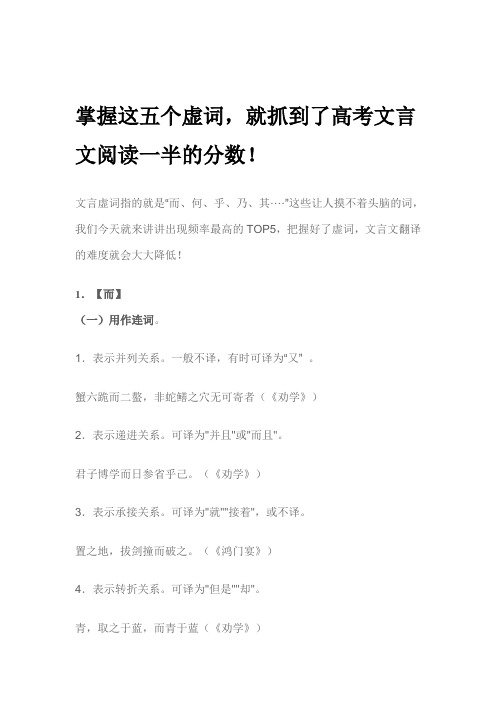
掌握这五个虚词,就抓到了高考文言文阅读一半的分数!文言虚词指的就是“而、何、乎、乃、其····”这些让人摸不着头脑的词,我们今天就来讲讲出现频率最高的TOP5,把握好了虚词,文言文翻译的难度就会大大降低!1.【而】(一)用作连词。
1.表示并列关系。
一般不译,有时可译为“又” 。
蟹六跪而二螯,非蛇鳝之穴无可寄者(《劝学》)2.表示递进关系。
可译为"并且"或"而且"。
君子博学而日参省乎己。
(《劝学》)3.表示承接关系。
可译为"就""接着",或不译。
置之地,拔剑撞而破之。
(《鸿门宴》)4.表示转折关系。
可译为"但是""却"。
青,取之于蓝,而青于蓝(《劝学》)5.表示假设关系。
可译为"如果""假如"。
死而有知,其几何离(《祭十二郎文》)6.表示修饰关系,即连接状语。
可不译。
吾尝跂而望矣,不如登高之博见也(《劝学》)7.表示因果关系,余亦悔其随之而不得极夫游之乐也(《游褒禅山记》)8.表示目的关系,缦立远视,而望幸焉(《阿房宫赋》)(二)通“尔”,用作代词,第二人称,译为"你的";偶尔也作主语,译为"你"。
(三)通“如”:好像,如同。
军惊而坏都舍。
(《察今》)2.【何】(一)用作疑问代词。
1.单独作谓语,后面常有语气助词"哉""也",可译为"为什么""什么原因"。
何者?严大国之威以修敬也。
(《廉颇蔺相如列传》)2.作动词或介词的宾语,可译为"哪里""什么"。
译时,"何"要后置。
大王来何操?(《鸿门宴》)3.作定语,可译为"什么""哪"。
文言虚词(包括解析和翻译)

文言虚词(包括解析和翻译)编辑整理:尊敬的读者朋友们:这里是精品文档编辑中心,本文档内容是由我和我的同事精心编辑整理后发布的,发布之前我们对文中内容进行仔细校对,但是难免会有疏漏的地方,但是任然希望(文言虚词(包括解析和翻译))的内容能够给您的工作和学习带来便利。
同时也真诚的希望收到您的建议和反馈,这将是我们进步的源泉,前进的动力。
本文可编辑可修改,如果觉得对您有帮助请收藏以便随时查阅,最后祝您生活愉快业绩进步,以下为文言虚词(包括解析和翻译)的全部内容。
文言虚词1.而兵者,危道也,须戮力同心。
蟹六跪而(1)二螯,非蛇鳝之穴无可寄托者也,而况(2)战乎?故冯婉贞曰:“诸君而(3)有意,瞻予马首可也。
”婉贞,而(4)翁豪杰者,然青取之于蓝而(5)青于蓝。
婉贞博学而(6)日参省乎己,非特效书生终日而(5)思也。
众应之.既而(8),婉贞率诸少年结束而(9)出,果大捷。
众皆叹:婉贞,小女子而已(10);其行,乃巾帼英杰而(11).解析:(1)连词,表并列。
(2)复音词,即“何况",用反问语气表示更进一层的意思。
(3)连词,表假设。
(4)代词,通“尔".你,你的.(5)连词,表转折。
(6)连词,表递进.(7)连词,表修饰。
(8)复音词,不久,一会儿。
(9)连词,表承接。
(10)复音词,放在句尾,表限制的语气助词,相当于“罢了”。
(11)语气助词,表肯定语气.翻译:用兵,是一种变幻莫测的方法。
要同心协力,千万不要像螃蟹那样六条腿两只钳,不然,那么你凭什么取胜呢?所以冯婉贞说:“诸位将军如果想打胜仗,可以向我学习。
"冯氏年龄虽然小,但是青出于蓝而胜于蓝,冯氏比其父更胜一筹。
冯婉贞广泛的学习并且每天反省自己,不是效仿一般的书生那样整天思考(而不学习)。
多加考虑之后再去实施,所以抵抗敌军能够取得胜利.(冯氏)不是人们所说的柔弱女子,而是巾帼英雄啊.2.其狐谓狼曰:“羊肉其(1)鲜乎!君其(2)有意,叼其(3)一而啖之,得饱其(4)口福。
Chapter 5 简单虚词的翻译

2. “了”的英译
结构助词“了”的基本意义是表示动
作或状态的完成,多与过去时或完成 体对应。例如: •我给你拨了三次电话都没通。 I dialed three times but failed to get through to you.
•水位已上升到了警戒水位。 The water level has rise3. “的”表示肯定语气。例如: •我会告诉她的。 I sure will tell her. (sure adv. 当然,的确)
4. “的”位于谓语动词之后,强调动作的实 施者。例如: •我画的草图,她上的色。 I made the sketch; she filled in the colors.
1.It’s a present, not a purchase. 2.You’ve come in the nick of time. in the nick of time 副词性短语:恰好 3.Have you studied the works of Shakespeare?
3.“过”的英译
“过”表示一度或曾经发生的行为或状态,
表示主语的一种经验,多与英语现在完 成时对应。例如: 他经历过的世事太多了。 He has seen so much of life. / He has experienced so much.
习题:
1.这是人家送的,不是买的。 2.你来得正是时候。 3. 你研究过莎士比亚的作品吗?
3. “得”表示程度、结果的英译 表示程度、结果的“得”英译时,方法 比较多。例如: •她笑得肚子疼。 She laughed till her sides split. (till+状语从句) split v. 劈开,裂开
文言文中18个虚词的含义
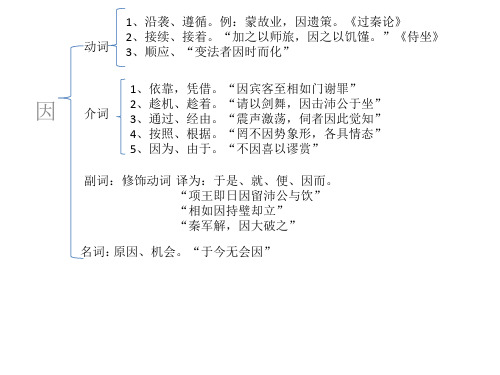
【既···且】又···又“三军既惑且疑” 【且···且】一边···一边 “且战且退”
副词 暂且、姑且 (表时间)
“存者且偷生,死者长已矣!” 《石壕吏》 “誓不相隔卿,且暂还家去。” 《孔雀东南飞》
将、将要 “有怠而欲出者,曰:‘不出,火且尽’” 《游褒禅山记》 “且为之奈何”“若属皆且为所虏”《鸿门宴》
主谓之间:❶逆接关系:但是、却 “君子而不仁者有矣夫” ❷假设:如果“相鼠有皮,人而无义,人而无义,不死何为?”
状动之间:修饰关系,不译。(“而”两边的动词关系不平等,主次关系) “弃甲曳兵而走” “(烛之武)夜缒而出”“(荆轲)倚柱而笑”
代词:通“尔”
1、顺接,就、便、那么··· “故木受绳则直,金就砺则利。”《劝学》
助词
1、句末,了、呢、啊(常与其他语气词联用) “至丹以荆卿为计,始速祸焉。”《六国论》
“寡人之于国也,尽心焉耳矣!”
2、句中,表停顿,不译 “句读之不知,惑之不解,或师焉,或否焉,小学而大遗。” 《师说》
“少焉,月出于东山之上,徘徊于斗牛之间。” 《赤壁赋》
3、形容词词尾,···的样子、···地 “盘盘焉,囷囷焉,蜂房水涡,矗不知乎几千万落。” 《阿房宫赋》
❶作状语,可放动词前,也可放动词后(后置)。“树之以桑”
❷可省略宾语。“五十者可以衣帛”
❸宾语也可前置。“一言以蔽之”
【固定搭配】
[有以]有可以用来···的东西 [无以]没有可以用来···的东西 [可以]可以用···来 [所以]之所以···的原因 [是以]因此
两谓词间,译为:而且、并且//来、用来、不译
《过秦论》
1、动词,像,好像。 其若是,孰有御之。《孟子见梁襄王》
1. “你”“你们”;作定语时则译为“你的”。
文言文虚词解释及翻译

一、之1. 解释:之,代词,可指代人、事物、地方等;也可作为助词,用于主谓之间,取消句子独立性。
2. 翻译:(1)吾友之病,久矣。
(我的朋友生病,已经很久了。
)(2)楚人伐宋,宋人御之。
(楚国人攻打宋国,宋国人抵抗他们。
)二、其1. 解释:其,代词,指代前面提到的人或事物;也可作为副词,表示推测、可能等。
2. 翻译:(1)其人善战,必胜。
(那个人善于战斗,一定会胜利。
)(2)其时,天下大乱。
(那时候,天下大乱。
)三、者1. 解释:者,助词,用于句末,表示停顿,使句子完整。
2. 翻译:(1)君子者,善以言辞自辩。
(君子,善于用言语为自己辩解。
)(2)古人者,仁义之至也。
(古人,仁义的极致。
)四、以1. 解释:以,介词,表示手段、方法、原因等;也可作为连词,表示目的、原因等。
2. 翻译:(1)吾以剑舞,志在千里。
(我用剑跳舞,志向在千里之外。
)(2)以其言辞,取悦于君。
(通过他的言辞,取悦于君主。
)五、于1. 解释:于,介词,表示时间、地点、范围等。
2. 翻译:(1)吾生于乱世,难以自保。
(我生于乱世,难以自保。
)(2)其地广于中原。
(那个地方比中原更广阔。
)六、而1. 解释:而,连词,表示并列、转折、递进等关系。
2. 翻译:(1)君子而仁,小人而忍。
(君子仁爱,小人残忍。
)(2)其色悦而声哀。
(他的脸色和悦,声音哀怨。
)七、之乎者也1. 解释:之乎者也,文言文中常见的句末语气词,表示疑问、感叹等。
2. 翻译:(1)此为何物?之乎?(这是什么?哎呀!)(2)吾欲归去,其可乎?(我想回家,可以吗?)总之,文言文虚词丰富多样,了解并掌握这些虚词,对于理解文言文具有重要意义。
在阅读文言文时,要学会根据上下文来判断虚词的意义和用法,从而更好地理解文意。
常见18个文言虚词用法归类-含例句翻译
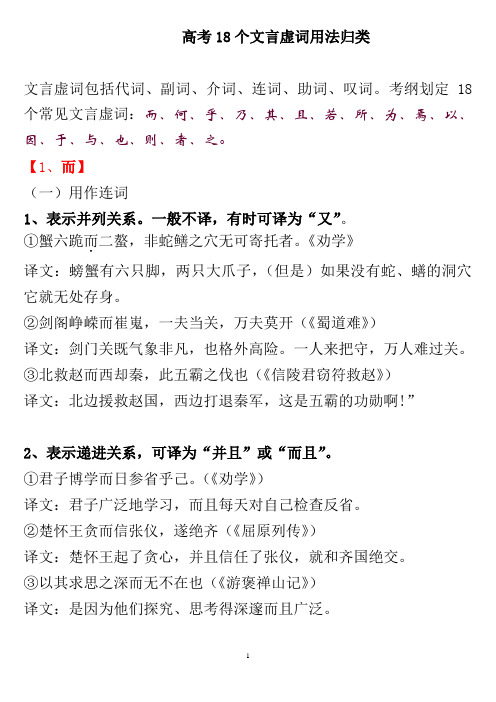
高考18个文言虚词用法归类文言虚词包括代词、副词、介词、连词、助词、叹词。
考纲划定18个常见文言虚词:而、何、乎、乃、其、且、若、所、为、焉、以、因、于、与、也、则、者、之。
【1、而】(一)用作连词1、表示并列关系。
一般不译,有时可译为“又”。
①蟹六跪而.二螯,非蛇鳝之穴无可寄托者。
《劝学》译文:螃蟹有六只脚,两只大爪子,(但是)如果没有蛇、蟮的洞穴它就无处存身。
②剑阁峥嵘而崔嵬,一夫当关,万夫莫开(《蜀道难》)译文:剑门关既气象非凡,也格外高险。
一人来把守,万人难过关。
③北救赵而西却秦,此五霸之伐也(《信陵君窃符救赵》)译文:北边援救赵国,西边打退秦军,这是五霸的功勋啊!”2、表示递进关系,可译为“并且”或“而且”。
①君子博学而日参省乎己。
(《劝学》)译文:君子广泛地学习,而且每天对自己检查反省。
②楚怀王贪而信张仪,遂绝齐(《屈原列传》)译文:楚怀王起了贪心,并且信任了张仪,就和齐国绝交。
③以其求思之深而无不在也(《游褒禅山记》)译文:是因为他们探究、思考得深邃而且广泛。
3、表示承接关系,可译尾“就”“接着”“来”。
可不译。
表示承接关系,可译为“就”“接着”“来”。
可不译。
①置之地,拔剑撞而破之。
(《鸿门宴》)译文:把它丢在地上,拔出剑砍,使玉斗破碎。
②人非生而知之者,孰能无惑(《师说》)译文:人不是一生下来就懂得道理的,谁能没有疑惑?③苏子愀然,正襟危坐而问客曰。
(《赤壁赋》)译文:我有些忧伤,理好衣襟端正地坐着,问那客人说。
④“学而时习之,不亦说乎?《论语》译文:学了知识然后按一定时间去复习,不也很愉快的吗?⑤温故而知新,可以为师矣。
《论语》译文:复习学过的知识,可从中获得新的见解与体会了。
凭借这点就可以当老师了。
”⑥择其善者而从之,其不善者而改之。
《论语》译文:要选择他们的长处来学习,如果看到他们的短处自己也有,就要帮助改正自己与他们一样的习惯。
"4、表示转折关系,可译为“但是”“却”。
18个虚词小故事原文 翻译
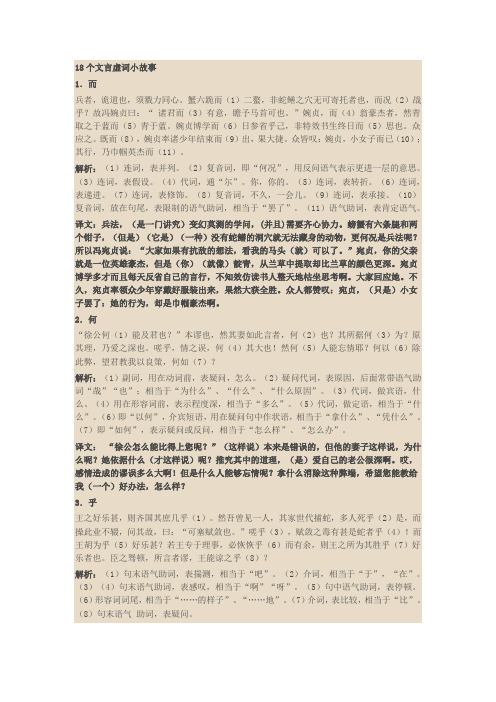
18个文言虚词小故事1.而兵者,诡道也,须戮力同心。
蟹六跪而(1)二螯,非蛇鳝之穴无可寄托者也,而况(2)战乎?故冯婉贞曰:“ 诸君而(3)有意,瞻予马首可也。
”婉贞,而(4)翁豪杰者,然青取之于蓝而(5)青于蓝。
婉贞博学而(6)日参省乎己,非特效书生终日而(5)思也。
众应之。
既而(8),婉贞率诸少年结束而(9)出,果大捷。
众皆叹:婉贞,小女子而已(10);其行,乃巾帼英杰而(11)。
解析:(1)连词,表并列。
(2)复音词,即“何况”,用反问语气表示更进一层的意思。
(3)连词,表假设。
(4)代词,通“尔”。
你,你的。
(5)连词,表转折。
(6)连词,表递进。
(7)连词,表修饰。
(8)复音词,不久,一会儿。
(9)连词,表承接。
(10)复音词,放在句尾,表限制的语气助词,相当于“罢了”。
(11)语气助词,表肯定语气。
译文:兵法,(是一门讲究)变幻莫测的学问,(并且)需要齐心协力。
螃蟹有六条腿和两个钳子,(但是)(它是)(一种)没有蛇鳝的洞穴就无法藏身的动物,更何况是兵法呢?所以冯宛贞说:“大家如果有抗敌的想法,看我的马头(就)可以了。
”宛贞,你的父亲就是一位英雄豪杰,但是(你)(就像)靛青,从兰草中提取却比兰草的颜色更深。
宛贞博学多才而且每天反省自己的言行,不知效仿读书人整天地枯坐思考啊。
大家回应她。
不久,宛贞率领众少年穿戴好服装出来,果然大获全胜。
众人都赞叹:宛贞,(只是)小女子罢了:她的行为,却是巾帼豪杰啊。
2.何“徐公何(1)能及君也?”本谬也,然其妻如此言者,何(2)也?其所据何(3)为?原其理,乃爱之深也。
嗟乎,情之误,何(4)其大也!然何(5)人能忘情耶?何以(6)除此弊,望君教我以良策,何如(7)?解析:(1)副词,用在动词前,表疑问,怎么。
(2)疑问代词,表原因,后面常带语气助词“哉”“也”;相当于“为什么”、“什么”、“什么原因”。
(3)代词,做宾语,什么。
(4)用在形容词前,表示程度深,相当于“多么”。
常考文言文单字翻译

一、实词翻译1. 名词(1)山:指山脉、山峰等。
如:“登高望远,山川秀丽。
”(翻译:登上高山,远眺景色,山川秀丽。
)(2)水:指河流、湖泊等。
如:“春江水暖鸭先知。
”(翻译:春天江水温暖,鸭子先知道。
)(3)人:指人类。
如:“人非圣贤,孰能无过?”(翻译:人不是圣贤,谁能没有过错?)2. 动词(1)行:指行走、行动。
如:“行百里者半九十。
”(翻译:走一百里路,九十里已经过去了。
)(2)食:指吃饭、吃。
如:“民以食为天。
”(翻译:人民把吃饭当作头等大事。
)(3)言:指说话、表达。
如:“言者无罪,闻者足戒。
”(翻译:说话的人没有罪,听的人可以引以为戒。
)3. 形容词(1)大:指体积、数量大。
如:“大江东去,浪淘尽,千古风流人物。
”(翻译:长江东去,浪涛冲刷,洗尽千古风流人物。
)(2)美:指美丽、美好。
如:“窈窕淑女,君子好逑。
”(翻译:婉约美丽的女子,是君子所喜爱的配偶。
)(3)善:指善良、美好。
如:“善者不来,来者不善。
”(翻译:善良的人不轻易来,来的人不一定是善良的。
)二、虚词翻译1. 介词(1)于:表示在某个时间、地点、范围等。
如:“于月黑风高之夜。
”(翻译:在月黑风高的夜晚。
)(2)以:表示用、凭借。
如:“以德服人。
”(翻译:用道德来感化人。
)2. 连词(1)而:表示并列、递进、转折等。
如:“学而时习之,不亦说乎?”(翻译:学习并且经常温习,不是很愉快吗?)(2)则:表示结果、原因等。
如:“不积跬步,无以至千里。
”(翻译:不积累一小步,就无法达到千里之遥。
)三、总结掌握文言文单字翻译技巧,有助于我们更好地理解文言文,提高阅读文言文的能力。
在实际学习中,我们要多加积累,熟练掌握常用文言文单字及其翻译,为深入学习文言文打下坚实基础。
初中文言文必考翻译词语
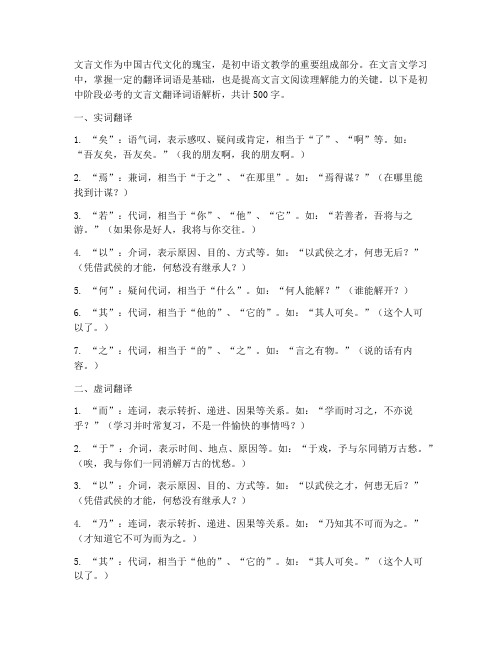
文言文作为中国古代文化的瑰宝,是初中语文教学的重要组成部分。
在文言文学习中,掌握一定的翻译词语是基础,也是提高文言文阅读理解能力的关键。
以下是初中阶段必考的文言文翻译词语解析,共计500字。
一、实词翻译1. “矣”:语气词,表示感叹、疑问或肯定,相当于“了”、“啊”等。
如:“吾友矣,吾友矣。
”(我的朋友啊,我的朋友啊。
)2. “焉”:兼词,相当于“于之”、“在那里”。
如:“焉得谋?”(在哪里能找到计谋?)3. “若”:代词,相当于“你”、“他”、“它”。
如:“若善者,吾将与之游。
”(如果你是好人,我将与你交往。
)4. “以”:介词,表示原因、目的、方式等。
如:“以武侯之才,何患无后?”(凭借武侯的才能,何愁没有继承人?)5. “何”:疑问代词,相当于“什么”。
如:“何人能解?”(谁能解开?)6. “其”:代词,相当于“他的”、“它的”。
如:“其人可矣。
”(这个人可以了。
)7. “之”:代词,相当于“的”、“之”。
如:“言之有物。
”(说的话有内容。
)二、虚词翻译1. “而”:连词,表示转折、递进、因果等关系。
如:“学而时习之,不亦说乎?”(学习并时常复习,不是一件愉快的事情吗?)2. “于”:介词,表示时间、地点、原因等。
如:“于戏,予与尔同销万古愁。
”(唉,我与你们一同消解万古的忧愁。
)3. “以”:介词,表示原因、目的、方式等。
如:“以武侯之才,何患无后?”(凭借武侯的才能,何愁没有继承人?)4. “乃”:连词,表示转折、递进、因果等关系。
如:“乃知其不可而为之。
”(才知道它不可为而为之。
)5. “其”:代词,相当于“他的”、“它的”。
如:“其人可矣。
”(这个人可以了。
)6. “者”:助词,用于主语后,起停顿作用。
如:“此乃吾师也。
”(这就是我的老师。
)三、特殊句式翻译1. “宾语前置”:将宾语提前至主语之前,如:“吾友矣。
”(我的朋友啊。
)2. “定语后置”:将定语放在中心词之后,如:“人皆曰予可矣。
常见18个文言虚词用法归类_含例句翻译
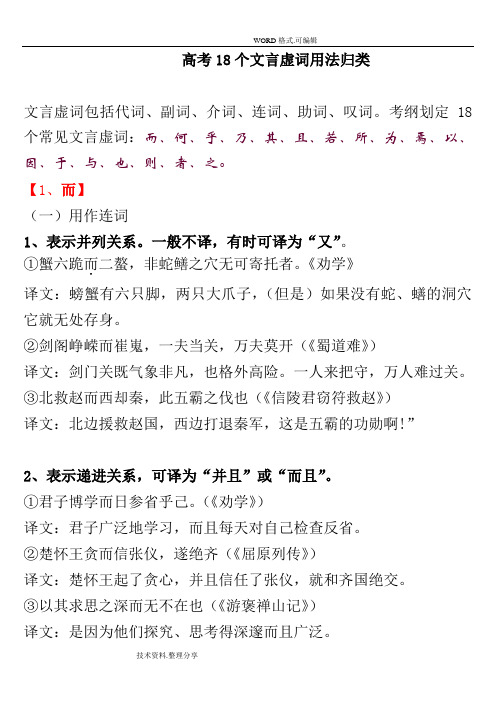
高考18个文言虚词用法归类文言虚词包括代词、副词、介词、连词、助词、叹词。
考纲划定18个常见文言虚词:而、何、乎、乃、其、且、若、所、为、焉、以、因、于、与、也、则、者、之。
【1、而】(一)用作连词1、表示并列关系。
一般不译,有时可译为“又”。
①蟹六跪而.二螯,非蛇鳝之穴无可寄托者。
《劝学》译文:螃蟹有六只脚,两只大爪子,(但是)如果没有蛇、蟮的洞穴它就无处存身。
②剑阁峥嵘而崔嵬,一夫当关,万夫莫开(《蜀道难》)译文:剑门关既气象非凡,也格外高险。
一人来把守,万人难过关。
③北救赵而西却秦,此五霸之伐也(《信陵君窃符救赵》)译文:北边援救赵国,西边打退秦军,这是五霸的功勋啊!”2、表示递进关系,可译为“并且”或“而且”。
①君子博学而日参省乎己。
(《劝学》)译文:君子广泛地学习,而且每天对自己检查反省。
②楚怀王贪而信张仪,遂绝齐(《屈原列传》)译文:楚怀王起了贪心,并且信任了张仪,就和齐国绝交。
③以其求思之深而无不在也(《游褒禅山记》)译文:是因为他们探究、思考得深邃而且广泛。
3、表示承接关系,可译尾“就”“接着”“来”。
可不译。
表示承接关系,可译为“就”“接着”“来”。
可不译。
①置之地,拔剑撞而破之。
(《鸿门宴》)译文:把它丢在地上,拔出剑砍,使玉斗破碎。
②人非生而知之者,孰能无惑(《师说》)译文:人不是一生下来就懂得道理的,谁能没有疑惑?③苏子愀然,正襟危坐而问客曰。
(《赤壁赋》)译文:我有些忧伤,理好衣襟端正地坐着,问那客人说。
④“学而时习之,不亦说乎?《论语》译文:学了知识然后按一定时间去复习,不也很愉快的吗?⑤温故而知新,可以为师矣。
《论语》译文:复习学过的知识,可从中获得新的见解与体会了。
凭借这点就可以当老师了。
”⑥择其善者而从之,其不善者而改之。
《论语》译文:要选择他们的长处来学习,如果看到他们的短处自己也有,就要帮助改正自己与他们一样的习惯。
"4、表示转折关系,可译为“但是”“却”。
2025届高考语文文言虚词

吾尝终日而思矣,不如须臾之所 学也。(《劝学》)
上一页 下一页
高考总复习
返回目录
类型
常用词语及意义
对接教材
疑问 代词
代人:谁、孰——谁、哪一个
吾孰与徐公美?(《邹忌讽齐王 纳谏》)
代事物:何、胡、奚、曷、盍—— 大王来何操?(《鸿门宴》)
什么、哪里
表处所:安、恶(乌)、焉——哪里 沛公安在?(《鸿门宴》)
乃不知有汉,无论魏晋。(《桃 花源记》)
表反诘:岂、其、庸、巨(讵)、宁— 夫庸知其年之先后生于吾乎?
—难道、哪里、怎么
(《师说》)
上一页 下一页
高考总复习
返回目录
类型
常用词语及意义
对接教材
指代性 相:互指、偏指——相互、我、他
久久莫相忘。(《孔雀东南飞 并序》)
副词 见:动作行为的接受者——自己、 生孩六月,慈父见背。(《陈
第、直——只、仅、只是
(《蜀道难》)
程度 副词
表少非深、常度 殊 、: 、 分稍 外很、,、微稍极、微、略、甚略、——微绝很、、至太、、良极、、颇特、别酷、, 于 而是 歌饮 之酒 。乐(《甚赤,壁扣赋舷》) 表比较:益、弥、尤、愈、加、滋——更加、 圣益圣,愚益愚。
尤其、更、越
(《师说》)
上一页 下一页
高考总复习
返回目录
类型
常用词语及意义
对接教材
表方式:俱、并、间、微、窃、固—— 又间令吴广之次所旁丛
一起、暗中、坚决
祠中。(《陈涉世家》)
情态
表速度:遽、卒(猝)、立、即、旋、暂, 如听仙乐耳暂明。(《琵
副词 稍、渐、益——立刻,暂且,逐渐、稍 琶行并序》)
微
2022语文五文言虚词含解析

课时作业(五)文言虚词(本栏目内容,在学生用书中以独立形式分册装订!)阅读下面的文段,翻译文中画线的句子。
1.(钱乙)本有羸疾,性简易,嗜酒,疾屡改,自以意治之,辄愈。
最后得疾,惫甚,乃叹曰:“此所谓周痹(一种病)也,周痹入藏者死,吾其已夫!”(选自《宋史·钱乙传》)译文:解析:藏,通“脏”;其,表推测,大概;已,止,结束。
答案:(钱乙)最后一次犯病,憔悴(疲倦)得厉害,就叹息道:“这就是(医生)所说的周痹病,周痹进入脏腑的话(人)就要死了,我大概要完了!”2.(史弼)迁河东太守,受诏当举孝廉,弼知多权贵请托,乃豫敕断绝书属。
中常侍侯览果遣诸生赍书请之,积日不得通。
生乃以它事谒弼,而因达览书。
弼大怒曰:“太守忝荷重任,当选士报国,尔何人而伪诈无状!”命左右引出。
(选自《后汉书·史弼》)译文:解析:“以"“谒"“因”“达”。
答案:诸生就用其他的事为借口拜见史弼,于是趁机送上了侯览的书信。
3.君讳云章,字汉瞻,号朴村,江南嘉定人也.曩者崐山徐司寇好文术,以得士为名,而士亦以此附焉。
君始以校勘《宋元经解》客司寇家,其后诸公贵人考订文史,必以相属,而君尝就陆稼书先生问学,独阴以名义自砥.君在举场数十年,所与比肩游好次第登要津,司贡举,每欲引手,君辄曲避,以是终无所遇.康熙五十二年,诏求岩穴之士。
时华亭王司空承修《尚书》,奏君参校;书既成,而君淹留逾时,众以为疑.余间诘其所以然,君曰:“假予急功利,乃侘傺到今邪?顾窃自念,生逢明圣,平生所志,具上殿劄子[注],欲进见时一自列之耳。
”(选自方苞《张朴村墓志铭》)[注]劄(zhá)子:古时官用上奏的一种文书。
(1)君始以校勘《宋元经解》客司寇家,其后诸公贵人考订文史,必以相属。
译文:解析:“以”“客"“以……属”。
答案:张朴村开始是因为要校勘《宋元经解》而客居在司寇家里的,这之后,许多达官显贵考证修订文史资料,也一定要把这项工作委托给他。
文言虚词故事及翻译

文言虚词小故事1.而兵者,诡道也,须戮力同心;蟹六跪而1二螯,非蛇鳝之穴无可寄托者也,而况2战乎故冯婉贞曰:“诸君而3有意,瞻予马首可也;”婉贞,而4翁豪杰者,然青取之于蓝而5青于蓝;婉贞博学而6日参省乎己,非特效书生终日而5思也;众应之;既而8,婉贞率诸少年结束而9出,果大捷;众皆叹:婉贞,小女子而已10;其行,乃巾帼英杰而11;解析:1连词,表并列;2复音词,即“何况”,用反问语气表示更进一层的意思;3连词,表假设;4代词,通“尔”;你,你的;5连词,表转折;6连词,表递进;7连词,表修饰;8复音词,不久,一会儿;9连词,表承接;10复音词,放在句尾,表限制的语气助词,相当于“罢了”;11语气助词,表肯定语气;译文:兵法,是一门讲究变幻莫测的学问,并且需要齐心协力;螃蟹有六条腿和两个钳子,但是它是一种没有蛇鳝的洞穴就无法藏身的动物,更何况是兵法呢所以冯宛贞说:“大家如果有抗敌的想法,看我的马头就可以了;”宛贞,你的父亲就是一位英雄豪杰,但是你就像靛青,从兰草中提取却比兰草的颜色更深;宛贞博学多才而且每天反省自己的言行,不知效仿读书人整天地枯坐思考啊;大家回应她;不久,宛贞率领众少年穿戴好服装出来,果然大获全胜;众人都赞叹:宛贞,只是小女子罢了:她的行为,却是巾帼豪杰啊;2.何“徐公何1能及君也”本谬也,然其妻如此言者,何2也其所据何3为原其理,乃爱之深也;嗟乎,情之误,何4其大也然何5人能忘情耶何以6除此弊,望君教我以良策,何如7解析:1副词,用在动词前,表疑问,怎么;2疑问代词,表原因,后面常带语气助词“哉”“也”;相当于“为什么”、“什么”、“什么原因”;3代词,做宾语,什么;4用在形容词前,表示程度深,相当于“多么”;5代词,做定语,相当于“什么”;6即“以何”,介宾短语,用在疑问句中作状语,相当于“拿什么”、“凭什么”;7即“如何”,表示疑问或反问,相当于“怎么样”、“怎么办”;译文:“徐公怎么能比得上您呢”这样说本来是错误的,但他的妻子这样说,为什么呢她依据什么才这样说呢推究其中的道理,是爱自己的老公很深啊;哎,感情造成的谬误多么大啊但是什么人能够忘情呢拿什么消除这种弊端,希望您能教给我一个好办法,怎么样3.乎王之好乐甚,则齐国其庶几乎1;然吾曾见一人,其家世代捕蛇,多人死乎2是,而操此业不辍,问其故,曰:“可塞赋敛也;”嗟乎3,赋敛之毒有甚是蛇者乎4而王胡为乎5好乐甚若王专于理事,必恢恢乎6而有余,则王之所为其胜乎7好乐者也;臣之驽顿,所言者谬,王能谅之乎8解析:1句末语气助词,表揣测,相当于“吧”;2介词,相当于“于”,“在”;34句末语气助词,表感叹,相当于“啊”“呀”;5句中语气助词,表停顿;6形容词词尾,相当于“……的样子”、“……地”;7介词,表比较,相当于“比”;8句末语气助词,表疑问;译文:大王喜欢音乐太投入了,那么齐国治理得也差不多了吧;但是我曾经看到一个人,他家世代捕蛇,有多人死在这件事上,却仍然做这件事不停下来,问他原因,他说:“捕蛇可以应付赋税啊;”哎,赋税的危害真是比毒蛇还厉害啊然而大王您为什么还如此沉溺于音乐呢如果大王在治理国事上专心致志,一定会游刃有余的,这样的话大王的作为真是比耽溺于音乐强百倍啊;为臣愚钝,所说的话难免有误,大王能原谅我吗4.乃尝闻放翁志节,毕现示儿,乃1读之;至“王师北定中原日,家祭无忘告乃2翁”一句,大为感佩,乃3忠贞之士也然亦有人不齿,乃4曰:“此徒沽名耳;”众人质之以理,其辞穷,乃5不得已而谢;原其言,炒作乃尔6,无乃7自高耳;解析:1副词,表承接,于是;2代词,用作第二人称,“你”、“你的”;3副词,表判断,相当于“为”、“是”、“就是”;4副词,表转折,相当于“竟然”、“却”;5副词,表条件,相当于“才”;6复音虚词,相当于“样子”;7复音虚词,表猜测,相当于“恐怕……吧”;译文:曾经听说陆放翁的节操气节,全都表现在示儿这首诗里,于是读了读它;读到“王师北定中原日,家祭无忘告乃翁”这句,深深地受到感动并佩服他,陆放翁真是忠诚正直的臣子啊然而也有人瞧不起他,竟然说;“这只是沽名钓誉罢了;”大家向他询问道理,他无话可说,才不得不道歉;推究他说的话,恐怕是炒作来抬高自己的名气吧;5.其狐谓狼曰:“羊肉其1鲜乎君其2有意,叼其3一而啖之,得饱其4口福;”狼曰:“其5如猛犬何”狐间于犬曰:“羊数詈言,其6言不堪入耳,君乃无所怒,其7无闻邪,其8畏主人邪及其9嬉逐,愿为一雪其10耻;君其11许之”犬笑曰:“欲加之罪,其12无辞乎”犬乃悟狐之野心,知路曼曼其13修远矣,护羊愈谨;狐与狼遂去;解析:1副词,表揣测语气,大概、或许;或表感叹语气,多么,真;2连词,表假设,如果;3指示代词,其中的;4第一人称代词,自己的;5副词,加强反问语气,又;6第三人称代词,他的;78连词,连用,表选择,是……还是……;9第三人称代词,它们;10指示代词,那种;11副词,加强祈使语气,表希望、要求,相当于“一定”、“还是”;12副词,表反问语气,难道、怎么;13音节助词,起调节音节作用,不译;译文:狐狸对狼说:“羊肉真鲜美啊”您如果想尝一尝,叼来其中的一只吃掉它,就能够一饱自己的口福了;狼说:“那如何对付猛犬呢”狐狸就到猛犬那里离间说:“羊好多次说你坏话,他们说的话不堪入耳,您却一点不生气,是没听到呢,还是害怕主人呢等到他们嬉戏打闹的时候,我想为您把这耻辱全部洗刷掉;希望您答应我”猛犬笑着说:“想要给他加上罪名,难道还怕没有借口吗”猛犬于是明白了狐狸的野心,知道守护羊群的道路很漫长,守护羊群更加谨慎;狐狸与狼就离开了;6.且“存者且1偷生,死者长已矣”,此岂石壕一地,中晚唐王朝尽然耳;若此,帝尚每日笙歌,且2委政奸佞之人,则李唐且3亡,必矣;且夫4志士且如5河水清且6涟矣,于斯世则无进身之途;纵有“死且7不避,卮酒安足辞”之豪气,无用武之地,亦何用解析:1副词,暂且、姑且;2连词,表递进,而且、并且;3副词,将要;4复音词,用在句首,表示下文要进一步议论,况且,再说;5复音词,就像;6连词,表并列关系,又;7连词,表让步关系,尚且、还;译文:“活着的人姑且苟活着吧,死去的人就永远逝去了;”这难道只是石壕一个地方的现象吗中晚唐王朝全都这样啊;国家治理得都像这个样子了,皇帝仍然每天玩乐,而且把朝政委托给奸佞的人,因此李唐将要灭亡,是一定的了;再说有志之士就像河水那样清澈见底,在这样的世道上就没有入仕做官报效国家的道路了;纵使他有“连死都不躲避,一杯酒怎么值得拒绝”的勇气,却没有用武之地,又有什么用呢7.若“若1为化得身千亿,散向峰头望故乡;”奇哉若2人之思,若3天惊石破,花开铁树,非若4等凡人可及也,吾亦如此;恐吾辈但堪为其鱼之一鳞,若5龙之一爪也;若夫6常人思乡,常望月怀远,登高作赋,若7柳子厚则不然,以超人之思,抒难抑之情,绝矣;解析:1连词,表假设,如果;2指示代词,此,这个;3副词,表推测,好像;4第二人称代词,你;5连词,相当于“或”;6和“夫”连用,构成复音虚词;句首语气词,用在一段或一层意思开头,表示转换,有“在说”、“至于”的意思;7连词,表示另提一件事,相当于“至”、“至于”;译文:“如果能够化身为千亿个自我,那就散到那无数的山峰上眺望故乡;”真是奇妙啊这个人的想象,就像石破天惊,铁树开花一样,并不是你们这些平常的人能够赶得上的;我也是这样;恐怕我们这些人只能够作鱼的一片鳞龙的一只爪了;至于一般人思念家乡,常常是眺望明月怀念远方,或者登上高处吟诗作赋,至于柳子厚就不这样,他凭借超过一般人的思路,抒发难以抑制的感情,绝了;8.所“吾所以1为此者,以先国家之急而后私仇也”,蔺相如此言,足使之为天下所2钦;以其所3居位,能如此,岂他人可及察其言,观其行,知其非所以4沽名钓誉矣;与之相伯仲者,信陵君也,其于众人广坐之中,不宜有所5过之时,前访朱亥,其度岂常人哉此二人皆所6以教人向上者也;解析:1助词,与“以”构成固定复音虚词“所以”,表原因,相当于“……的原因缘故”;2助词,与“为”构成固定结构“为……所……”,表被动;35助词,“所+动词”构成名词性的所字结构,表示“……的人事物、地方、情况等”;46助词,与“以”构成固定复音虚词“所以”,可译为用来……,……的方法途径、手段;译文:“我这样做的缘故,是把国家的危机放在前面而把一己的私怨放在后面;”蔺相如的这句话,值得使他被天下人钦佩;凭借他所居的官位,能够这样说这样做,难道是别人能比得上的吗仔细研究他的言行,就知道他并不是凭此沽名钓誉了;与他不相上下的人,是信陵君;侯生在大庭广众之间,不应该有过访朋友的事情的时候,前去拜访朱亥,而信陵君始终面不更色,这气度难道是一般人吗这两个人都是教人向上的榜样啊;9.为“天行有常,不为1尧存,不为2桀亡;”此为3至理,当为4世人言之,切勿使之为5巫所惑;巫者,以诡为6业,其所为7皆为8利也;故为9其来也,即斥之以此理,彰其用心;为10天下除残去秽,乃吾辈本分,何辞为11解析:12介词,表动作、行为的原因,相当于“因为”;3非虚词用法,动词,是;4介词,表示动作、行为的对象,相当于“对”;5介词,与“所”构成固定结构“为……所……”,表被动,相当于“被”;67动词,作为,做;8介词,表动作、行为的原因,相当于“为了”;9介词,表示动作、行为的时间,相当于“当”、“等到”;10介词,表示动作、行为的替代,相当于“给”、“替”;11句末语气助词,表示疑问或反诘,相当于“呢”;译文:“上天的运行有一定的规律,不会因为圣君尧就存在,也不会因为暴君桀就灭亡了;”这是真理,应当对世人说说它,千万不要让他们被巫师迷惑;巫师,拿骗人当职业,他所做的事情都是为了利益;所以当他来到的时候,就用这个道理斥责他,揭露他的用心;替社会清除坏的风气习俗,这是我们的分内之事,为何推辞拒绝呢10.焉秦军过崤山间,见峭峭焉1,狭狭焉2,未料有伏焉3,将士虽全力以搏,无奈进退不能,少焉4,死之殆尽,故致大败;于是余有叹焉5,骄而轻敌若此,焉6能不败万军于之何加焉7但以其傲,斥焉8,则必无颜世上矣;解析:12形容词词尾,约同于“然”,相当于“……的样子”;3兼词,相当于“于彼”,在那里;4句中语气助词,表示停顿;5语气助词,不译;6疑问代词,怎么,哪里;7句末语气助词,相当于“呢”;8代词,相当于“之”,他们;译文:秦军路过崤山,看到那里山势陡峭狭窄,没有料到晋国在那里设有埋伏,将士们虽然全力拼搏,无奈进退两难,不久,差不多都战死了,所以导致大败;对这件事我很有感慨,如此骄傲轻敌,怎么能不打败仗即使千军万马对他们又有什么益处呢就因为他们骄傲,斥责他们,他们一定没脸在世上活着了;11.也“师道之不传也1久矣,汝何以能复之也2”“吾将劝勉督责以行之也3;”“汝之言,金玉也4;汝之心胸,吾辈何能及也哉5”解析:1句中语气助词,表停顿,舒缓语气,引起下文;2句末语气助词,表疑问或反诘语气;3句末语气助词,表肯定语气;4句末语气助词,表判断语气; 5句末语气助词,与“哉”连用,表感叹语气译文:“从师的风尚不流传已经很久了,你凭什么能恢复它呢”“我将劝勉并监督大家和我一起来践行它;”“你的话,如同金玉;你的心胸,我们怎么能比得上啊”12.以“秉烛夜游,良有以1也;”若以2己美于潘安,则出无伤;否则,以3吾之容现于当衢,则恐惊人;故自当以4书卷为伴,弃险以5远则不敢至之怯,慕“拥火以6入深穴”之勇,醉“木欣欣以7向荣,泉涓涓而始流”之美……畅游书海以8极夫天地之乐,如此,以9帝位予我,亦弃之也, 岂以10一冕之故而弃心神之逸以11吾有如此之意,故方能长享逸乐;吾虽以12康熙六年至京师,然终未以13权贵交;以14上乃吾心之剖白,希汝能察之,故不必有“贤不见用,忠不见以15”之叹;解析:1名词,原因;2动词,认为;3介词,动作行为所用或所凭借、依据的工具、方法及其他,凭借;4介词,把;5连词,相当于“而”,表并列;6连词,相当于“而”,表承接关系;7连词,相当于“而”,表修饰关系,连接状语和中心词;8连词,表目的关系,可译为“来”;9介词,起提宾作用,可译为“把”;10介词,表示动作行为产生的原因,可译为“因”、“因为”;11连词,表原因,可译为“因为”;12介词,引进动作、行为发生的处所,可译为“在”;13介词,表示动作、行为的对象,可译为“跟”、“和”;14助词,与“上”组合,表界限或范围;15动词,可译为“用”;译文:“古代的人秉烛夜游,的确是有原因的啊;”如果认为自己比潘安还英俊潇洒,那么出来走走也没什么妨碍;否则,凭借我这幅面容出现在街市上,就恐怕要吓到人了;所以我自己应当把书卷作为伙伴,消除掉因为危险而遥远就不敢到达的怯懦,仰慕“拿着火把进入深穴探险”的勇气,陶醉在“树木欣欣向荣,泉水缓缓流动”的美景之中……畅游于书海之中来穷极那天地之间的快乐,像这样,即使把皇帝的位子给我,我也会弃之不顾的,难道我会因为一顶皇冠的缘故就抛弃精神的悠然闲逸吗正因为我有这样的志向,所以才能够长久地享受闲逸和快乐;我虽然在康熙六年就到京城了,但是始终没有跟权贵交往;以上就是我内心的表白,希望你能体察,因此没必要有“忠臣贤能之人不被任用”的感叹;13.因因1能授官,不以门第取人,且不因2旧制,此乃曹操成大业之因3;其常因4人不备,袭取之,如乌巢焚粮;此一役,动摇袁绍军心,因5乘势击破之,成官渡大捷;此亦因6许攸之力而得;途经绍墓,因7守冢至前拜祭;其量岂常人可比因8此其得众人之心,以一天下;因9其有非常之量,故能就非凡之业;解析:1介词,根据,依靠,凭借;2 动词,沿袭;3名词,原因;4介词,趁着,趁此;5副,于是,就;6介词,凭借7介词,经由,通过;8介词,因为;9连词,连接分句,用于因果关系复句的前一个分句,表示原因,可译为“因为”;译文:根据才能授予官职,不依据出身高低录用人才,而且不沿袭旧制度,这就是曹操成就大业的原因;他常常趁敌人没有准备,突袭击败他们,例如乌巢火烧粮草;这一次战役,动摇了袁绍的军心,于是就趁着有理的时机打败了袁绍,取得官渡一战的大胜;这一战的胜利也是凭借许攸的帮助而取得的;后来曹操路过袁绍的坟墓,通过守墓人来到坟前拜祭他;这气量难道是一般人能比的因为这些他得到大家的拥戴,从而统一天下;因为曹操有非同一般的胸怀气量,所以他能够成就非凡的事业;14.于“黄鸟于1飞,差池其羽”,何其美也;然于2吾等,则久别矣;自十年前偶见之,于3今已十载,未睹其姿;今造林还草,生态渐复,黄鸟复见,其鸣之美则倍于4昔,吾乡之美誉于5四方;世人皆欲老于6吾乡,此乃多人言于7我也,非吾杜撰耳;于8是吾等畅饮抒怀,陶然醉于9是, 不亦乐乎解析:1助词,动词词头,不译;2介词,引进动作行为的对象,对于;3介词,引进动作行为相关的时间,到;4介词,引进比较的对象,表程度的比较,;5介词,引进动作行为的主动者,表示被动,被;6介词,引进动作行为的地点,在;7介词,引进动作行为的对象,对,向;8与“是”构成复音虚词“于是”,相当于“对此”;9介词,引进动作行为相关的处所,在;译文:“黄雀缓缓地飞,美丽的翅膀参差翩然”,多么美好啊;然而对于我们来说,是长久没有看到的了;自从十年前偶而见过一次,到如今已经十年,没有看到它们的身影;如今造林还草,生态渐渐恢复,黄鸟又可以见到了,它的鸣叫比以前美一倍;我们乡的美已经闻名于四方;世界上的人都想在我们这里养老,这是好多人对我说的,不是我杜撰的;在这时候我们畅饮几杯酒来抒发情怀,陶醉在这里,不是很好吗15.与朝过夕改,君子与1之,吾亦赞同;然今人与2古人孰智,庙堂与3坊间之识,相去甚远;为国者,与4清廉之君子,离奸佞之小人,身体力行,事乃成;今恩足以及外夷,而功不至于彼百姓者,独何与5吾等与6君建言,又恐君自与7吾复算耳;解析:1动词,赞许;2与“孰”组成文言固结构“与……孰……”,相当于“跟……比较,哪一个……”;3连词,表并列,和,跟,同;4动词,结交,亲附;5通“欤”,句末语气助词,表疑问,呢;6介词,表施动者发出动作行为所涉及的对象,相当于“为”;7介词,和,跟,同;译文:一个人如果在早上犯了过错到晚上就能改正,那么君子就会赞许他,我也赞同;但是,现代人与古人谁更有智慧,对此朝廷与百姓的认识,相差很大;治理国家的人,亲近清正廉明的彬彬君子,远离奸邪而善于谄媚的小人,凡事以身作则亲身实践,事业才会成功;如今您的恩德足以惠及外邦,但却不能到达本国百姓那里,这唯独是为什么呢我们给您提建议,又害怕您跟我们算账啊;16.则“此则1岳阳楼之大观也”,道出岳阳楼之美,然岳阳楼之闻名,非徒借此也;若如此,则2天下如岳阳楼者多矣,何独显其名范希文若不应邀作赋,文播寰宇,则3岳阳楼能名扬天下与当世之风,位卑则4足羞,官盛则5近谀,范氏则6不然,高唱“不以物喜,不以己悲”之调;友人被贬,未别离去,众人避之惟恐不及,及知,赶至河边,则7已在舟中矣,足见其性情之笃;解析:1副词,表示肯定,起强调、确认作用,可译为“就是”,“是”;2 连词,表让步转折关系,用在前一分句,可译为“倒是”;3连词,表示条件、假设关系,用在后一句句首,表示叙述的事、理中是一种假设或推断,可译为“那么”“那就”“就”;45连词,并列,两个或两个以上的“则”连用,每个“则”字都用在意思相对,结构相似的一个分句中,表示各分句之间是并列关系;译为“就”,或不译;6连词,转折,可译为“却”7连词,表承接,第一件事不发生在第二件事之前,只是有了第一件事之后才发生第二件事,译为“原来是”“原来已经”;译文:“这就是岳阳楼的壮丽景观啊”,这句话说出了岳阳楼的壮美,但是岳阳楼名满天下,并非只凭借这个;如果这样,那么普天之下像岳阳楼的建筑多了,为什么只有岳阳楼天下闻名呢范希文如果不应邀作赋,文章散布天下,岳阳楼能名闻天下吗当今的风气,与地位低的人交往就认为这是值得羞耻的事情,遇到官职高的就追随着阿谀奉承;范希文却不是这样,高唱“不以物喜,不以己悲”的调子;他的朋友被贬官,大家躲避他都恐怕来不及;等到他知道了,急忙追赶到河边,朋友已经在船上了,可见他性情的忠厚;17.者李白者1,诗仙也;为当国者2所拒,遂游于此山;今者3,山中与幽人对酌,乃一浇其心中块垒也;力士脱靴,国忠捧墨,诗讽杨妃,此数者4乃其得罪之源,亦其个性之抒扬,故虽仕途失意,仍不辍伟志,发之于诗,其诗传于后世者5不可胜计,遂就其万世英名;解析:1助词,用在判断句主语的后边,起提顿作用,不译;2助词,附在别的词或短语之后,组成名词性短语,指称上文所说的人、事、物,译为“的人”“的事”“的东西”“的想法”“的做法”;3助词,放在时间词之后,起语气助词作用,不译;4助词,放在数词之后,可译为“……方面”“……样东西”“个”“样”之类;5助词,定语后置标志;译文:李白,是诗仙啊;被统治者拒之门外,就在这座山中游赏;如今,他在山中与远离尘嚣的人对饮,是为了抒发心中的郁结之情啊;让高力士为他脱靴,让杨国忠为他捧墨,写诗讽刺杨贵妃,这几件事是他得罪统治者的根源,也是他个性张扬的表现;所以他虽然仕途上不如意,却仍然不放弃伟大的志向,并在诗歌里抒发出来,他流传后世的诗篇不可计数,于是成就了他万世英名;18.之一僧欲之1南海,询于唐僧,久之2,唐僧不之3应;其独往,其待也与均之4二策,僧以箪食瓢饮至南海,夸之5于唐僧:“此何难之6有”唐僧曰:“汝之7百折不挠,实可钦佩;然汝之8言亦过矣,君将骄而笑之9乎”解析:1动词,可译为“到”、“往”;2助词,调节音节,用在时间词后,不译;3代词,可译为“他”;4指示代词,表近指,可译为“这”;5代词,可译为“这件事”;6助词,宾语前置标志,不译;7助词,用在主谓之间,取消句子独立性,不译;8结构助词,可译为“的”;9人称代词,表第一人称,可译为“我”;译文:一个僧人想要去南海,向唐僧询问打算邀请他同去,过了很久,唐僧也不回应他;是独自去呢,还是等待唐僧答应他一起去呢均衡了一下这两个想法,这个僧人凭借着很简陋的条件到达了南海,回来后向唐僧夸耀说:“这件事有什么困难的呢”唐僧说:“你百折不挠的精神的确值得钦佩;但是你的话也有些过分了吧,你要骄傲地笑话我吗”。
白话文翻译文言文虚词
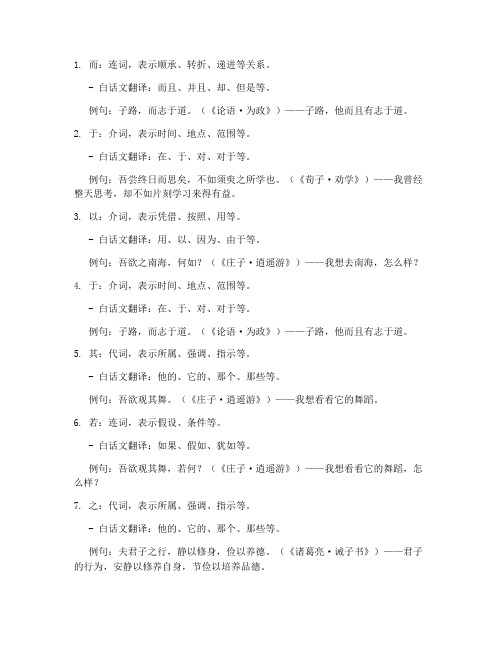
1. 而:连词,表示顺承、转折、递进等关系。
- 白话文翻译:而且、并且、却、但是等。
例句:子路,而志于道。
(《论语·为政》)——子路,他而且有志于道。
2. 于:介词,表示时间、地点、范围等。
- 白话文翻译:在、于、对、对于等。
例句:吾尝终日而思矣,不如须臾之所学也。
(《荀子·劝学》)——我曾经整天思考,却不如片刻学习来得有益。
3. 以:介词,表示凭借、按照、用等。
- 白话文翻译:用、以、因为、由于等。
例句:吾欲之南海,何如?(《庄子·逍遥游》)——我想去南海,怎么样?4. 于:介词,表示时间、地点、范围等。
- 白话文翻译:在、于、对、对于等。
例句:子路,而志于道。
(《论语·为政》)——子路,他而且有志于道。
5. 其:代词,表示所属、强调、指示等。
- 白话文翻译:他的、它的、那个、那些等。
例句:吾欲观其舞。
(《庄子·逍遥游》)——我想看看它的舞蹈。
6. 若:连词,表示假设、条件等。
- 白话文翻译:如果、假如、犹如等。
例句:吾欲观其舞,若何?(《庄子·逍遥游》)——我想看看它的舞蹈,怎么样?7. 之:代词,表示所属、强调、指示等。
- 白话文翻译:他的、它的、那个、那些等。
例句:夫君子之行,静以修身,俭以养德。
(《诸葛亮·诫子书》)——君子的行为,安静以修养自身,节俭以培养品德。
8. 与:介词,表示并列、关联等。
- 白话文翻译:和、与、以及等。
例句:吾与子游于吴。
(《庄子·逍遥游》)——我和你在吴国游玩。
9. 是:代词,表示肯定、强调等。
- 白话文翻译:这个、这样、如此等。
例句:是可忍也,孰不可忍也?(《左传·僖公二十五年》)——这样都可以忍受,还有什么不可以忍受的呢?10. 则:连词,表示因果、转折等。
- 白话文翻译:那么、就、却等。
例句:子曰:“学而时习之,不亦说乎?”(《论语·学而》)——孔子说:“学习了然后按时温习,不是一件很愉快的事吗?”通过以上对文言文虚词及其白话文翻译的介绍,我们可以看出,文言文虚词在表达上的灵活性和丰富性。
- 1、下载文档前请自行甄别文档内容的完整性,平台不提供额外的编辑、内容补充、找答案等附加服务。
- 2、"仅部分预览"的文档,不可在线预览部分如存在完整性等问题,可反馈申请退款(可完整预览的文档不适用该条件!)。
- 3、如文档侵犯您的权益,请联系客服反馈,我们会尽快为您处理(人工客服工作时间:9:00-18:30)。
四、表示强调的汉语语气词的英译 在对表示强调的语气词进行翻译时,除使用 表示强调的英语词汇外,还可以采用倒装或强调 句式等句法手段。例如: · 我们公司已经政企分开了呢。 In our company the functions and responsibilities of administration just have been separated from those of management.
第五章 词的翻译(下)——虚词的翻译
[<]
· 已经有两位中国女选手取得了100米蝶游的决赛 权。 Two Chinese women swimmers have already entered the 100-metre butterfly stroke finals. · 升旗仪式就要开始了。 The flag raising ceremony is about to start.
第五章 词的翻译(下)——虚词的翻译
[<]
· 由于实力差别悬殊,整场比赛中中国队自始至终 信心十足,而日本队则显得斗志不高。 There is a considerable gap in actual strength between the Chinese team and the Japanese team. Accordingly, the former was confident of winning all the time, while the latter seldom was. · 我们现在多么尊敬约翰逊教授啊,可从前总嘲笑 他。 How much we respect Professor Johnson now, whom we used to laugh at so much.
第五章 词的翻译(下)——虚词的翻译
[<]
· 这事他做得出。 He is capable of doing such a thing. · 他这人是老虎屁股摸不得。 He is like a tiger whose backside no one dares to touch.
第五章 词的翻译(下)——虚词的翻译
第五章 词的翻译(下)——虚词的翻译
[<]
3.“过”的英译 “过”表示一度或曾经发生的行为或状态,表示 主语的一种经验,多与英语现在完成体对应。例 如: · 他到过号称人间天堂的苏杭,也去过山水甲天 下的桂林。 He has been to Suzhou and Hangzhou, the renowned places called “paradise on earth”; he has also visited Guilin, a city noted the world over for its picturesque rivers and mountains. · 他经历过的世事太多了,不可能不痛感于斯。 He has seen only too much of life to feel it keenly.
第五章 词的翻译(下)——虚词的翻译
[<]
六、表示强调的语气副词的英译 这类词有“可、倒、竟、偏、也、决不、究 竟、只好、难道”等。汉译英时,除译成表示强 调的词汇外,还可借助疑问句、感叹句、倒装句 或把被强调部分置于主语或表语的位置上等手段。 例如: · 你可来了! So you are here at last.
第五章 词的翻译(下)——虚词的翻译
[<]
五、时间状语副词的英译 前面说过,汉语主要以词汇手段表示时态, 即添加时态助词和时间副词;英语主要靠动词形 态变化表示时态。因此,很多情况下,汉语时间 副词可转换成英语时态。例如: · 这几年我们一直强调科技在农业发展中的作用。 For years we have been stressing the important role of science and technology in the development of agriculture.
第五章 词的翻译(下)——虚词的翻译
[<]
1. “的”是定语的标志。例如: · 她的父亲是研究员。 Her father is a research fellow. 2. “的”是“的”字结构的标志。例如: · 格的(checked)是我的, 印花的(printed)是你的。 The checked is mine, the printed is yours.
第五章 词的翻译(下)——虚词的翻译
[<]
· 他可不就是白手起家的么。 Indeed, he simply built up from nothing. 本句采用了表示强调的英语词汇。 · 你既然当上了局长,可得廉洁奉公啊! Now you are the head of the bureau, mind you be honest in performing official duties. 本句采用了表示强调的英语词汇。 · 他们不仅劫持了你的钱财,还把东西都砸了呢。 Not only did they rob you, they smashed everything, too. 本句采用了倒装形式。
第五章 词的翻译(下)——虚词的翻译
[<]
2. “了”的英译 结构助词“了”的基本意义是表示动作或状态的 完成,多与过去时或完成体对应。例如: · 我给你拨了三次电话都没通。 I dialed three times but failed to get through to you. · 水位已上升到了警戒水位。 The water level has risen to the warning stage.
第五章 词的翻译(下)——虚词的翻译
[<]
· 她听着音乐睡着了。 She fell asleep while listening to music. “着”还有其他用法:附加在“站”、“坐” 等表示物体状态、姿态的动词后,或附加在某些 短暂性动词后,英译时,常与一般时对应;附加 在连动式第一个动词后,表示伴随,可译成英语 不定式、介词短语、现在分词等。例如:
第五章 词的翻译(下)——虚词的翻译
[<]
TRANSLATION TECHNIQUES (P59) 虚词的翻译 汉英语言中都有实词与虚词之分。实词表示 人物、时间、动作、数量、性质等概念,有实在 意义。虚词无实义,只表示结构关系或在句中起 辅助作用,为功能词。 一、“的”的翻译 将汉语“的”字翻译成英文时,首先要弄清 它的功能,这是十分重要的。“的”字的功能主 要有以下三种:
第五章 词的翻译(下)——虚词的翻译
[<]
· 不得触摸展品。 Hands off the exhibits. 2. “得”表示可能、能够的英译 汉译英时,可利用can (could), be able to, be capable of, 也可借助带后缀 -able 或 -ible 表示可 能的形容词。 · 这次踢主场,咱们可输不得。 This time we are the host team, and we can’t afford to lose the game.
第五章 词的翻译(下)——虚词的翻译
[<]
此外,“了”附加在形容词后表示既成事实,英 译时,可用比较级转换。例如: · 长大后,他出息了好多。 He became more agreeable when he grew up. · 保值储蓄 (inflation-proof savings) 推出后,该储 蓄所储户的存款(deposit) 热情高了好多。 With the introduction of inflation-proof savings service, people are more willing to deposit their money in the savings bank.
第五章 词的翻译(下)——虚词的翻译
[<]
七、连词的英译 英语中表示转折、条件、假设、因果、并列等关系的 手段非常多,如副词、介词(短语)、分词(短语)、复合结 构、从句等。汉语连词英译的情况比较复杂。这里着重 介绍几种比较特殊的情况。 1. 译为关系从句 英语关系从句可表示转折、条件、假设等关系。关 系从句的适当运用,可使译文更自然、流畅。
[<]
3. “得”表示程度、结果的英译 表示程度、结果的“得”英译时,方法比较多。 例如: · 她笑得肚子疼。 She laughed till her sides split. (till+状语从句)
· 例子多得不胜枚举。 Instances are too numerous to list. (too...to)
第五章 词的翻译(下)——虚词的翻译
[<]
· 原来竟是她父亲。 It is her father after all. (It is no other than her father.) · 我们决不容许他人干涉我们的内政。 In no way will we have others interfere in our domestic affairs. · 你听到的正是贝多芬的《月光》奏鸣曲。 What you are listening to is Beethoven’s piano sonata entitled Moonlight.
第五章 词的翻译(下)——虚词的翻译
[<]
· 他竖着耳朵听外面有何动静。 He picked up his ears, trying to tell what was outside. · 那个小姑娘含着眼泪走开了。 The little girl went away with tears in her eyes. · 他闭着眼装睡。 He closed his eyes, pretending to be asleep.
第五章 词的翻译(下)——虚语气。例如: · 我会告诉她的。 I sure will tell her.
